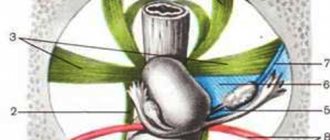The consequences of IVF for children conceived this way can be very diverse. After numerous studies by foreign and Russian specialists, it was concluded that an IVF child has a higher risk of intrauterine growth retardation, hypoxia, and perinatal damage to the nervous system. Their mothers were over 30-40 years old, suffered from infertility for 5-15 years, were unsuccessfully treated for it and had several chronic diseases.
Almost all women were at high risk of complicated pregnancy and childbirth.
The first IVF in the world to produce results was carried out in the UK in 1978. The first IVF child born from an egg “fertilized in vitro” was Louise Brown. To date, more than four million children have been born as a result of the IVF procedure.
And the question rightly arises: what negative IVF consequences can there be for a child and whether an IVF child will be able to have their own naturally conceived children.
Common consequences of IVF pregnancies include:
- premature birth;
- cases of low birth weight;
- developmental anomalies of the cardiovascular and musculoskeletal systems;
- neurological problems
The frequency of such disorders in children conceived by IVF is higher than in children from natural pregnancy. Children after IVF require especially careful monitoring by doctors and parents.
How to solve the problem of infertility?
Infertility is a serious problem faced by millions of couples. This problem is especially common in developed countries - this is due, first of all, to the lifestyle and sentiments prevailing in society. In the modern world, it is customary to first achieve material, rather than family, well-being, so there are often cases when partners begin to try to conceive a child at a fairly late age, when both are already 35 or more years old. However, not every organism is capable of conceiving at this time... In Russia, for example, according to statistics, 15% of families face such a phenomenon as infertility. If you are also affected by this misfortune, then you should not give up. There is a solution - IVF - a technology that helps conception!
Celebrity children
If all of the above is not convincing and you want some more arguments and evidence, then you can try to find “10 differences” between the ordinary children of your friends and the children of celebrities conceived in a laboratory. Here is just a small list of mothers who have undergone IVF and are raising such children:
- Julia Roberts - actress;
- Kristina Orbakaite – singer and actress (IVF was with Mikhail Zemtsov);
- Alla Pugacheva - singer (IVF married to Maxim Galkin);
- Zhanna Friske - singer (IVF with Dmitry Shepelev);
- Yulia Dzherbinova - actress (IVF married to Evgeny Dyatlov);
- Elena Borscheva is an actress, presenter, and KVN performer.
Why are children conceived through IVF no different from others?
Unfortunately, many still believe that such methods are beyond the bounds of what is permissible, that they should not be used, since children will inevitably suffer from some kind of abnormalities, etc. Meanwhile, in Western countries, IVF has been used for a long time and successfully . More than 30 years ago, in 1978, the first child conceived in vitro was born - a girl, Louise Brown, who had already become a mother herself. To date, there are about 5 million children born through in vitro conception in the world. Many of them already have their own children, born naturally. And science confirms the statement that there are no differences - studies conducted around the world cannot reveal any developmental abnormalities in children conceived in a natural cycle and children after IVF. And statistics even conclude that IVF babies are less likely to be born with Down syndrome , for example.
On November 10, 1977, the first successful implantation of an embryo into a woman’s uterus took place in the English city of Oldham. Louise Joy Brown is the first test tube baby that the whole world is watching. Thanks to physiologist Robert Edwards, the newborn's mother, Leslie Brown, was able to experience the joy of motherhood.
Over more than 40 years of the existence of the IVF method, about 7 million children were born, which makes it possible to conduct research and monitor the development of test-tube children, their level of health, intelligence, and possible infertility.
What myths exist around “eco-friendly” children?
- Children born through IVF are more likely to have genetic disorders.
As a rule, their occurrence is associated either with heredity or with the woman’s age, but not with IVF. Since women more often enter the IVF program after 35 years of age, the risk of chromosomal abnormalities at this age increases in the population as a whole. When implementing an IVF program, high-tech pre-implantation diagnostics are mandatory in all modern clinics. It allows you to accurately identify various genetic pathologies already on the 3rd day of embryo development. Thanks to this approach, the risks of having offspring with genetic abnormalities are always lower than under normal conditions.
- IVF produces children with poor health.
Long-term observations of children conceived by in vitro fertilization do not show a predisposition to frequent colds or other diseases. The version that IVF children are sick has no evidence. Such babies, like all others, undergo the required vaccinations and various preventive procedures. If IVF was carried out, the child’s health will always meet all age standards. In many cases, it is noted that IVF children are healthier than others, which is explained by carefully thought out conditions for their conception.
- Test tube babies are born infertile, unable to conceive on their own.
Proof of the fallacy of this opinion are the life stories of people born through in vitro fertilization. Experts say there is no reason to doubt whether IVF children can be born. Most of them have their own offspring, conceived naturally, and do not experience problems with reproductive health. Today, the question no longer arises whether IVF children can have their own children, and their infertility rate does not exceed standard indicators.
4. Mental development and intelligence.
There is an opinion that most IVF children suffer from various forms of autism.
That they are far behind their peers in intellectual development. And this is also a myth. The percentage of autistic people is quite low, which is confirmed by the results of the study. And it has also been proven that the development of autism in most cases is not associated with the form of conception of the child. As for mental retardation and low intelligence, then in this issue too there is unnecessary pressure. No sharp differences were found either.
Is IVF method safe?
Over its forty-year history, the IVF method has not only allowed about 7 million couples to become parents, but has also established itself as a safe way to get a long-awaited pregnancy when it turns out to be impossible to achieve in a natural way. Thanks to the improvement of this procedure, the likelihood of the child developing Down syndrome, hemophilia and other serious disorders is eliminated. The only likely risk with IVF is the onset of multiple pregnancies, which increases the burden on the female body.
Although recently the whole world has been striving to transfer only one selectively selected embryo. As a result of preimplantation diagnosis, it is possible to transfer one healthy embryo, which eliminates multiple pregnancies.
Why are IVF children ahead of their peers in development?
The fact is that medicine does not stand still - by turning to the IVF procedure, you also get the opportunity to identify various genetic abnormalities in the early stages. Using the preimplantation diagnosis (PGD) method, only one cell is taken from the embryo before being transferred into the woman’s body. Based on the chromosomes in it, geneticists judge the presence of risks of possible diseases in the unborn child - it is obvious that only healthy embryos are selected for gestation. Therefore, the number of children born through IVF, and at the same time having congenital genetic abnormalities, in our time tends to zero. All experts agree that the main determining factor in this process is the quality of the germ cells of the potential father and mother. Moreover, since these children are more long-awaited and desired, parents usually pay more care, warmth and affection to them, as well as attention to their upbringing and education. Therefore, in development, they are often ahead of their peers .
Who is recommended for genetic testing?
There are several risk groups for whom preimplantation genetic diagnosis (PGD) is recommended.
- women over 35 years old;
- men over 39 years old;
- married couples after repeated unsuccessful attempts to treat infertility using IVF
- men with severe disorders of spermatogenesis (single sperm, high percentage of abnormal sperm, etc.);
- women with a history of recurrent miscarriage (especially in cases of early pregnancy termination);
- history of unsuccessful IVF consequences (more than two);
- married couples with high genetic risk (family cases of hereditary diseases, karyotype abnormalities).
Infertile couples, especially those over 38 years of age and having the above diseases, are strongly recommended not to skimp when carrying out the procedure and to undergo PGD in order to later avoid negative IVF consequences and have healthier offspring.
Efficiency of IVF
With IVF, intervention in the birth of a child occurs only at the stage of conception, that is, when sperm and eggs specially selected from a couple are united together. The most viable embryos are transferred back into the body of the expectant mother, and then the process proceeds naturally.
Pregnancy can be diagnosed exactly two weeks after implantation. The effectiveness of one cycle is 30-35%, which is a very good indicator among all auxiliary methods. If it was not possible to conceive a child the first time, then experts recommend repeating the procedure 1-2 more times. Then your chances of success will more than double. Yes, more than 70% of families were able to become truly happy after 2-3 IVF cycles. Leave any doubts - make an appointment at one of more than 75 clinics throughout the country!
Are there risks?
As it became clear, when conceiving by in vitro fertilization, the risks of having children with various genetic pathologies, such as Down syndrome, hemophilia and others, are no higher, and often even lower. The only risk that is present with IVF is a multiple pregnancy, which puts a very significant burden on the woman’s body.
To increase the likelihood of successful implantation and pregnancy, several embryos can be introduced into a woman’s uterine cavity at once. According to the recommendations of the Ministry of Health of the Russian Federation, no more than 2 embryos are transferred into the uterine cavity. But 2 embryos can turn into 4 fetuses! Only if indicated, the doctor, upon obtaining the patient’s consent to transfer 3 embryos, can transfer more than 2 embryos.
Multiple pregnancy develops in approximately half of cases. In our clinic, the IVF procedure is carried out in accordance with medical standards, according to which no more than two embryos can be transferred into the uterine cavity, after which maintenance hormonal therapy is prescribed. Thanks to this, the risk of developing multiple pregnancies and complications associated with it is minimized.
What is a “Virtual IVF Tour”?
However, if you are not ready to get down to business so quickly, if you still have doubts and fears, then it’s worth looking at the whole process from the outside. IVF Virtual Tour program will help you with this! Together with Masha and Misha, the heroes of 9 short animated videos, you will easily go through all stages of the procedure, thereby overcoming internal contradictions and mentally preparing for a personal appointment with a specialist. This project is an important stage in the full-scale educational campaign “Happiness of Motherhood for Every Woman!”, which is carried out with the support of specialists from the Russian Association of Human Reproduction (RAHR).
IVF children and children conceived in a conventional way are absolutely no different. But they have something in common - warmth, love and affection, which you, as future parents, can convey to them. Give them life, and they will definitely fill yours with happiness!
About conception
To understand what IVF babies are like, you need to start from the very conception. During natural conception, the mother's egg meets the father's sperm in the wide part of the fallopian tube, and from there the fertilized egg enters the uterine cavity within 7-9 days after fertilization. With IVF, conception occurs outside the mother's body. An egg taken from a woman is fertilized in the laboratory by the father's sperm. Then the embryo (or more often, several embryos) is implanted into the uterine cavity, providing the expectant mother with accompanying hormonal therapy so that the conditions for the development of babies are closer to real, natural ones.
If the embryo takes root, the further course of pregnancy after IVF is not much different from natural, except that the woman is monitored more closely by doctors. The risks of miscarriage, hormonal disorders, multiple pregnancies, premature birth and placental pathologies are quite high.
The growth of a baby conceived in a test tube and the pace of its development completely coincide with similar parameters for a baby whom mom and dad conceived without the participation of doctors.
Many people believe that IVF is contrary to the laws of nature. If she has not provided for the possibility for a man or woman to reproduce their own kind, then (according to opponents of IVF) doctors have no right to interfere. There is practically nothing to oppose this opinion, except perhaps the happy eyes of spouses who become parents despite diagnoses.
At birth, IVF children are no different from their peers conceived naturally: neither in weight, nor height, nor in the size of body parts. These are the same kids who want parental love and affection, who rejoice in mom’s smile and dad’s hands. If conception occurs in the same way, but under different conditions, then where do the myths about “eco-friendly” children come from?
The fact is that humanity at all times has tended to mystify everything new and obscure. IVF has existed for only 40 years, which in the scale of history is comparable to only a second. It is not surprising that children conceived in a test tube are considered a miracle, an anomaly and even evil. It’s just that too little time has passed to understand what people are like, conceived in opposition to nature.
The first IVF was performed in 1978. A girl was born - Englishwoman Lisa Brown. Now she is 40 years old, she received a good education, made a career, and gave birth (conceiving naturally) to children. She is no different from her peers, does not suffer from rare diseases, and does not display any abnormal abilities.
In the USSR, the first IVF was done in Moscow, in 1986. The girl Elena Dontsova is also not much different from others. In total, at the beginning of 2021, there are more than five million people in the world conceived in vitro.
Since the early 2000s, the state began to financially support the in vitro fertilization program. IVF was included in the list of insurance medicine services, and now the procedure is available to everyone according to indications. This is why more and more children are being born who owe their birth to the work of reproductive doctors.
So, IVF is quite normal for modern society. Now let's move on to those myths that concern children conceived in vitro.
Religion and esotericism
Many religions have ambivalent attitudes towards the IVF procedure. In Orthodoxy, for example, it is generally accepted that a baby’s soul appears almost immediately, at the moment of fusion of the egg and sperm. In vitro fertilization, in which the doctor selects only the highest quality material from several fertilized eggs, is regarded by Orthodoxy as murder. The doctor, with the consent of the parents, according to the Russian Orthodox Church, kills the emerging life.
Not so long ago, parents who had the imprudence to inform the priest that the child was conceived through IVF could have difficulties baptizing the baby. The priests could have refused this. Now the attitude of the church has softened somewhat, and sometimes the priests themselves bless the couple for reproductive technologies. The Church still does not approve of surrogacy, the use of donor eggs and sperm, as well as the artificial selection of the strongest embryos from several living ones.
Islam has nothing against IVF, but requires its followers not to use the services of a surrogate mother or to use donor biomaterial. Only cells from the husband and wife should be used in the IVF protocol. Muslims believe that the soul comes and inhabits a child only 4 months after fertilization, and therefore Islam does not condemn artificial selection and rejection of embryos.
Jews believe that any methods for reproduction are good and justified. The attitude towards IVF is calm, balanced; in certain cases, surrogacy is also accepted and approved. Buddhists always welcome all innovations, including in the reproductive sphere. You can give life (in the understanding of Buddhist adherents) in any way, the main thing is that the parents love the baby, and he himself comes into this world desired and happy.
People who claim that children conceived through IVF do not have souls, that they have a different aura, a different energy, are deeply mistaken. Some possessed people have been ready to declare “witch hunts” at all times, and their “victims” usually become those who are at least somewhat different from themselves. The only difference between “eco” babies is the way they are conceived, and aura and energy are unconvincing arguments for those who cannot think of anything else.
Babies born after IVF are in no way biorobots, not androids, or humanoid creatures devoid of emotions and experiences. They are exactly the same children as everyone else, and therefore there is no point in mystifying their birth.
If you have religious or spiritual doubts, it is better to contact a clergyman, he will definitely help dispel them.
Infertility
It has long been believed that children born through reproductive technology are likely to have problems conceiving as adults. There is no need to worry about infertility. The first “eco” children, who are now 30-40 years old, showed by their example that they can have offspring. Conception occurs quite naturally.











